Car accidents involving pedestrians can result in serious injuries and raise questions about liability and fault. While many people assume that the vehicle's driver is always responsible for the accident, in some cases, the pedestrian may also be held liable. For individuals involved in such accidents, it is important to know under what circumstances a pedestrian may be at fault, as this can significantly impact potential legal action and insurance claims.
When a pedestrian's actions, such as crossing the road, walking in prohibited areas, or ignoring traffic signals, contribute to an accident, they may be found partially or wholly at fault. This could result in the pedestrian paying for their medical costs or even facing legal action from the driver or their insurance company. Understanding the factors determining fault in pedestrian accidents can help individuals navigate the complexities of liability and better assess their legal position.

Florida Pedestrian Accident Laws
Liability for pedestrian accidents is primarily determined based on negligence, which means that fault is attributed to the person who exhibited careless behavior that led to the accident. Drivers have a legal duty of care to look out for pedestrians and not injure them, but pedestrians also have to obey traffic rules and exercise caution when walking or crossing the road.
Determining Fault in Pedestrian Accidents
In Florida, drivers and pedestrians must behave responsibly and follow the rules of the road to ensure the safety of all road users. This includes obeying traffic signs and speed limits and yielding the right of way when necessary. In the event of a pedestrian accident, establishing fault is crucial to proving negligence and determining the party responsible for the accident.
To prove negligence, it must be shown that one party breached their duty of care, causing the accident and resulting in injuries. Sometimes, the driver and the pedestrian may be partially at fault. In Florida, the principle of comparative negligence applies, meaning that each party can be held liable for the damages in proportion to their share of the fault.
For example, if a pedestrian crosses the road at a red light and a vehicle collides with them at excessive speed, both parties can be held liable for the accident. The pedestrian's liability may result from disregarding the traffic light, while the car driver's liability may result from exceeding the speed limit.
Role of Traffic Signals and Laws
Traffic signs and laws are important in determining who is at fault for pedestrian accidents. Pedestrians and drivers must obey these laws to ensure safe traffic flow and protect all road users.
- Traffic Signals: In Florida, pedestrians must obey all traffic signals unless otherwise directed by a police officer. Failure to do so can contribute to a pedestrian being held liable in the event of an accident.
- Right of way: Pedestrians generally have the right of way on marked and unmarked crosswalks at intersections. Nevertheless, they must exercise caution and give way to oncoming vehicles if necessary.
- Sidewalks and crosswalks: Pedestrians should use them when they can walk safely and avoid accidents. Walking on the roadway when a sidewalk is present can increase a pedestrian's liability in a collision with a vehicle.
- Rules of the road: Both pedestrians and motorists must follow the rules outlined in Florida Statutes Chapter 316 Section 130. These rules cover several traffic safety issues, including speed limits, passing regulations, and the proper use of lights and signals.
In Florida, pedestrians can be held liable for an accident if they fail to obey traffic laws, disobey traffic signals, or act negligently. Knowing and following these laws can significantly reduce the risk of accidents and ensure the safety of pedestrians and drivers on the road.
Legal Framework and Negligence
Liability in accidents between motorists and pedestrians depends on the negligence laws, the duty of care, and the legal principles of contributory negligence and comparative negligence in the country where the accident occurred. Pedestrians and drivers must be aware of their responsibilities and follow the rules of the road to avoid endangering themselves and others.
Negligence and Duty of Care
In accidents between motorists and pedestrians, negligence law plays a crucial role in determining liability. Both motorists and pedestrians have a duty of care to behave responsibly and safely on the road. This means that each party must be aware of their surroundings and take the necessary precautions to avoid accidents.
For drivers, the duty of care includes the following
- Observe speed limits
- Giving way to pedestrians at crosswalks
- Concentrating on the road and avoiding distractions
Pedestrians, on the other hand, should:
- Use designated crosswalks and sidewalks
- Look both ways before crossing the road
- Obey traffic signals and signs
Comparative and Contributory Negligence
When determining liability in accidents between motorists and pedestrians, courts often consider the concept of contributory negligence or comparative negligence. These negligence concepts help to apportion responsibility based on the fault of the parties in causing the accident.
Contributory negligence means that a pedestrian found to be even partially at fault for the accident can be excluded from compensation. This legal principle is quite strict and only applies in a few jurisdictions.
In comparative negligence cases, pedestrians can receive compensation even if they were partially at fault, with the compensation awarded being reduced by the percentage of their fault. Comparative negligence can be further subdivided into:
- Pure comparative negligence: Here, damages are awarded in proportion to the percentage of fault. For example, if a pedestrian is found to be 40% at fault, they will receive 60% of the total damages.
- Modified comparative negligence: In this form, pedestrians can only receive compensation if their fault is below a certain percentage (usually 50%). If their fault exceeds this threshold, they cannot receive compensation.
Procedures After an Accident
By following these procedures and documenting all relevant information, drivers and pedestrians can better protect their rights and facilitate a fair settlement when determining liability in a car accident.
Steps to Take Following an Accident
If you are involved in a pedestrian accident, taking the right steps to resolve the situation and protect your rights is important. Here are some important steps you should take:
- Check for injuries: Check yourself and others for injuries, and call an ambulance if necessary.
- Contact the police: Notify the police to report the accident and request their presence at the scene.
- Get to safety: If possible, get to a safe place away from traffic without leaving the scene of the accident.
- Exchange information: Gather contact and insurance information from everyone involved, including driver(s), pedestrian(s), and witnesses.
- Keep a record: Document the incident by taking photos of the accident scene, injuries sustained, and any property damage. Note the date, time, and location of the accident.
Gathering Evidence and Information
A thorough collection of evidence and information is essential to establishing the liability of all parties involved in the accident. Here is a list of materials that can support your case:
- Police report: make sure a police report is filed, as it serves as official documentation of the accident and can provide important information about liability and contributing factors.
- Witness statements: Obtain the contact information and statements of witnesses present at the accident scene to support your version of events.
- Photos and videos: Capture visual evidence from the accident scene, including relevant traffic signals, road conditions, and vehicle damage.
- Medical records: Keep thorough records of medical treatments, diagnoses, and costs incurred due to the accident.
- Contact information: Maintain a list of all persons involved, including drivers, pedestrians, witnesses, and law enforcement officers.
Legal Representation and Actions
When involved in an accident with a pedestrian, it is crucial to know when to seek legal advice and how to proceed with legal action. This section is designed to help individuals injured while walking or crossing the street, consider potential liability, and seek legal information and resources.
When to Contact an Attorney
It's important to contact a pedestrian accident or personal injury lawyer as soon as possible after an accident. These attorneys are well-versed in the rights and responsibilities of pedestrians and motorists. An early consultation allows:
- The collection and preservation of evidence
- A proper assessment of the case
- Timely compliance with all legal deadlines
The advice of a pedestrian accident attorney can help determine whether the injured pedestrian, the driver, or both are at fault and what legal action may be appropriate. There are two primary paths for pursuing compensation for injuries sustained in a pedestrian accident.
Making Insurance Claim
This can be done with the driver's insurance company. An attorney can help navigate the process and negotiate fair compensation for medical bills, lost wages, and other damages. However, care should be taken when communicating with insurance adjusters, as they're primarily concerned with minimizing payouts for their company.
Filing a Lawsuit
If the insurance claim is unsuccessful or the case requires a more formal legal resolution, the injured party can file a personal injury lawsuit. The lawsuit can help recover damages such as:
- Medical expenses
- Lost wages
- Pain and suffering
- Emotional distress
In cases where the pedestrian suffers some contributory negligence, the legal doctrine of comparative negligence may come into play. Under this doctrine, damages may be reduced proportionately according to the degree of fault of each party.
Insurance and Compensation
After an accident with a pedestrian, the insurance claims process is an important step in determining fault and compensation.
Insurance Claims Process
If a pedestrian is blamed for an accident, he can be liable for medical expenses and other damages. On the other hand, if the driver is found at fault, the driver's insurance usually covers the pedestrian's injuries and losses. Most states require vehicle owners to carry minimum liability insurance that meets or exceeds state minimums.
The case can become more complicated in a shared-fault accident where both parties are found responsible. The consequences depend on the state's laws in which the accident occurred. To receive fair compensation, it is important to follow the insurance claims process closely and in a timely manner.
Seeking Compensation for Damages
Injured pedestrians have several legal options for obtaining compensation after an accident. Compensation can be claimed from their own insurance company, the liable driver's insurance company, or, in the case of joint fault, from both parties. There are various ways to claim compensation, including:
- Filing a Personal Injury Protection (PIP) claim: PIP coverage can cover the pedestrian's medical bills and other related expenses, regardless of who was at fault for the accident.
- Filing a liability insurance claim: If the driver is found to be at fault, the injured pedestrian can file a liability insurance claim with the driver's insurance company to cover medical expenses, pain and suffering, and lost wages.
- Filing a personal injury claim: In some cases, the injured pedestrian may seek legal representation and file a personal injury claim to receive fair compensation for their injuries and losses.
The correct procedure for claiming compensation depends on the circumstances of the accident, the allocation of fault, and the insurance companies involved. It is advisable to seek advice from legal and insurance experts to determine the best option for each case.
Speak To A Lawyer About Your Injuries
If you were injured while walking or crossing the street, you should speak to a personal injury lawyer about your case right away. The experienced attorneys at the Weinstein Legal Team are here to fight for fair compensation on your behalf so that you can focus on your recovery.
Contact the Weinstein Legal Team at 888-626-1108, or click here to schedule a free case review with one of our attorneys today.


